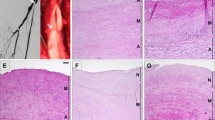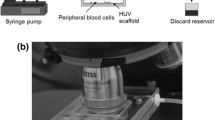Abstract
The purpose of this report was to study effects of shear force and hemodynamic conditions that influence fallout healing in the arterial and venous systems of the same dog. Knitted Dacron grafts made impervious by a 1.5 mm thick coat of silicone rubber bonded to the external surface were implanted for 4 weeks during the same surgery in the descending thoracic aorta (DTA), abdominal aorta (AA) and inferior vena cava (IVC) of each of five dogs. Flow rates were measured during surgery and shear stresses calculated with the Hagen-Poiseuille formula. Full-wall thickness longitudinal tissue sections were embedded in resin and stained with hematoxylin and eosin for light microscopy, and in paraffin for immunocytochemistry studies with Factor VIII/von Willebrand factor, smooth muscle α-actin, collagen IV, laminin, and proliferating cell nuclear antigen. Scanning electron microscopy and transmission electron microscopy studies were also performed. AgN03 was used to determine percentage of endothelial-like cell coverage on the flow surface. All grafts were patent, without hematoma or seroma. Endothelial-like cell coverage was highest in the IVC grafts and lowest in the DTA. Shear stress and flow velocity were significantly lower in IVC grafts than DTA and AA. Proliferating cell nuclear antigen indicated extensive cellular proliferation in the intima and in the interstices of the inner portion of the graft wall. The degree of fallout healing in knitted Dacron grafts made impervious by an external coat of silicone rubber varies inversely with the sheer force of blood flow in these grafts.
Similar content being viewed by others
References
Shi Q, Wu H-D, Hayashida N, Wechezak AR, Clowes AW, Sauvage LR. Proof of fallout endothelialization of impervious Dacron grafts in the aorta and inferior vena cava of the dog. J Vasc Surg 1994;4:546–557.
Zilla P, Oppell UV, Deutsch M. The endothelium: A key to the future. J Cardiovasc Surg 1993;8:32–60.
Herring MB, Baughman S, Glover J. Endothelium develops on seeded human arterial prostheses: A brief clinical note. J Vasc Surg 1985;2:727–730.
Sauvage LR, Berger K, Beilin LB, Smith JC, Wood SJ, Mansfield PB. Presence of endothelium in an axillary-femoral graft of knitted Dacron with an external velour surface. Ann Surg 1975;182:749–757.
Wu MH-D, Shi Q, Wechezak AR, Clowes AW, Gordon IL, Sauvage LR. Definitive proof of endothelialization of a Dacron arterial prosthesis in a human being. J Vasc Surg 1995;21:863–867.
Shi Q, Wu MH-D, Onuki Y, Ghali R, Hunter GC, Johansen KH, Sauvage LR. Endothelium on the flow surface of human aortic Dacron vascular grafts. J Vasc Surg 1996;25:735–742.
Budd JS, Allen KE, Bell PRF. Effects of two methods of endothelial cell seeding on cell retention during blood flow. Br J Surg 1991;78:878–882.
Rupnik MH, Hubbard FA, Pratt K, Jarrell BE, Williams SK. Endothelialization of vascular prosthetic surface after seeding or sodding with human microvascular endothelial cells. J Vasc Surg 1989;6:788–795.
Langille BL, Reidy MA, Kline RL. Injury and repair of endothelium at sites of flow disturbances near abdominal aortic coarctations in rabbits. Arteriosclerosis 1986;2:146–154.
Wechezak AR, Viggers RF, Coan DE, Sauvage LR. Mitosis and cytokinesis in subconfluent endothelial cells exposed to increasing levels of shear stress. J Cell Physiol 1994;159:83–91.
Carey DJ. Control of growth and differentiation of vascular cells by extracellular matrix proteins. Ann Rev Physiol 1991;53:161–177.
Sage EH, Bornstein P. Extracellular proteins that modulate cell-matrix interactions. SPARC, tenascin, and thrombo-spondin. (Review) J Biol Chem 1991;266:14831–14834.
Seeger JM, Klingman N. Improved endothelial cell seeding with cultured cells and fibronectin-coated grafts. J Surg Res 1985;38:641–647.
Ramalanjaona G, Kempczinski RF, Rosenman JE, Douville EC, Silberstein EB. The effect of fibronectin coating on endothelial cell kinetics in polytetrafluoroethylene grafts. J Vasc Surg 1986;2:264–272.
Dale WA. Synthetic grafts for venous reconstruction. In Bergan JJ, ed. Surgery of the Veins. Orlando: Grune & Stratton, Inc., 1985, pp 233–239.
Author information
Authors and Affiliations
Additional information
We appreciate the assistance of Dorothy Mungin, HT (ASCP), David Criss, Medical Photographer, Mary Ann Sedgwick Harvey, Medical Editor, and Mary-Ann Nelson, Medical Illustrator, for their contributions to this manuscript.
About this article
Cite this article
Shi, Q., Hong-De Wu, M., Onuki, Y. et al. The effect of flow shear stress on endothelialization of impervious dacron grafts from circulating cells in the arterial and venous systems of the same dog. Annals of Vascular Surgery 12, 341–348 (1998). https://doi.org/10.1007/s100169900165
Issue Date:
DOI: https://doi.org/10.1007/s100169900165




